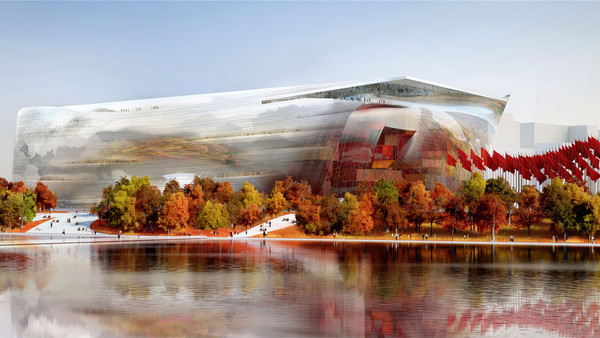Submitted by Berrin Chatzi Chousein
A stroke of genius: Jean Nouvel
Turkey Architecture News - May 21, 2013 - 19:49 4608 views
Jean Nouvel has seen off world-class rivals for the job of designing China’s National Museum
Image of Jean Nouvel's design for the mammoth National Art Museum of China
To stand out in contemporary China takes scale. To get noticed alongside the Bird’s Nest Stadium built for the 2008 Olympics demands a gesture. And to anchor a new museum district in a city where the monumental has become commonplace is going to need something remarkable.
Jean Nouvel is about to start building something that should do the job. The French architect behind the Louvre Abu Dhabi, the Fondation Cartier and the Institut du Monde Arabe in Paris has designed the breathtakingly bold new National Art Museum of China (Namoc) for Beijing, a vast structure which combines internal complexity with apparent external simplicity.
Such simplicity, in fact, that it is all based on a single line. Nouvel quotes to me the Chinese artist Shi Tao (1642-1707): “A single line is the source of everything in existence,” and this new museum is to be based on a single brush stroke. “We started with calligraphy,” he says. “Pupils used to spend half a year just on that first line with a brush. That first line contains all of Chinese culture – painting, writing and the energy of Chi.”
Nouvel has taken that stroke and translated it into a three-dimensional structure. The brush stroke, Nouvel writes in an essay, “starts off sharp in the south; its end, in the north, is round and smooth. Its whole body is taut with the energy-breath that runs through it and lifts it in a single movement.”
Each façade is an expression of the brush stroke expressed in different materials and atmospheres, from delicate pierced stone screens to striated and patterned glass. The building is oriented towards the main imperial axis leading north from the Imperial Palace and the Forbidden City but this is not a building with a single main entrance. Instead it touches the ground at four points and the motion of the “brush stroke” lifts the central section to allow visitors to wander freely in and out of a vast piazza beneath the body of the building.
Nouvel refers to this as the “summer lobby”, its undulating ceiling inscribed with delicate, almost art nouveau patterns of coloured foliage. Visitors will ascend through the building via lifts in the four cores to a first-floor “winter lobby”. This is a space which runs the entire 225m length of the building – Nouvel compares it to the Turbine Hall at Tate Modern. Coloured crimson like the inside of a Chinese lacquer box, its ceiling is formed by the volumes of all the individual galleries which are suspended above it, recalling a kind of constructivist sculpture.
The crown of the building is occupied by a glazed roof garden and restaurant, its glass floors allowing light to penetrate a row of galleries below. At its centre a vertical shaft (open to the sky in summer) descends right through to the basement of the building where the most delicate works on paper are displayed in a space that Nouvel describes as one “with only the memory of light”.
The section through the building reveals a collage of these colourful rooms suspended in space, more like a diagram of a bunker complex or a space station than a conventional building with floors and windows. It appears a completely interiorised volume.
But this inward-looking nature does not mean the exterior is inanimate: quite the opposite. Nouvel has taken care that the walls of this 65m tall object (about the same height as London’s Tower Bridge) should be alive with movement and pattern, light, reflection and shadow. He shows me renderings of views of the building in all the seasons, picking up and reflecting the colour of trees, leaves, blossoms and the landscape around it.
“It was imperative to make the museum a part of the landscape, to integrate it,” the architect tells me. “Sometimes you see the landscape reflected, with trees and green: it is a game of mirroring and reflection, matt and shiny surfaces and screens.
“You see people in the thickness of the wall,” he adds. “You have the feeling they are walking through the thickness of a brush stroke. It is always alive, with a sense of movement inside.”
I wonder about the translation of this most delicately two-dimensional of forms into such a huge mass of resolutely three-dimensional form. “Do you know the word compossibility?” Nouvel asks. I don’t. “It is about how you make one move and everything changes. There is only one mountain but all its faces are different.” Sounds gnomic. When I later look it up, I learn that this is a word coined by Leibniz and appropriated by Alain Badiou, who used it to mean a space able to contain “heterogenous truths”.
This is a determinedly heterogenous building, but one in which all faces face an idea of China. It is heralded on one side by a sea of red flags, on another by a dragon-shaped garden. Its walls echo watercolour landscapes, it encases Chinese gardens and its form is inspired by calligraphy. Nouvel is determined to counter accusations of the anonymity and placelessness of a global culture of starchitecture. This will be a difficult building to get right, as shoddy construction could render that intended delicacy grimly clumsy, more ink blot than brush stroke. But if its architect can contain those myriad images it might, in five years’ time, be one of the world’s great museums.
by Edwin Heathcote
via Financial Times
http://www.ft.com/intl/cms/s/2/3b98d098-be11-11e2-9b27-00144feab7de.html#axzz2Twibpmn0

